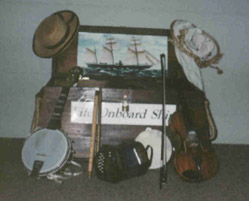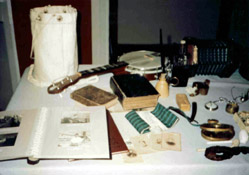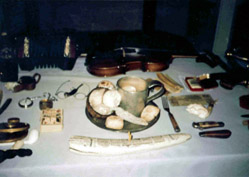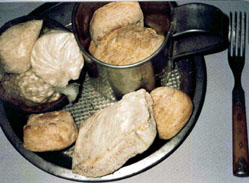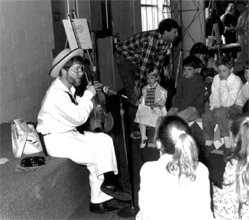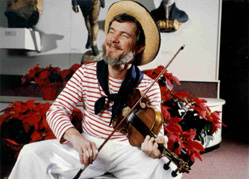|
By
John Townley
The
variously-titled
“Sailor’s Sea Chest Program” has
become a staple among both in-house demonstrations/exhibits and
portable
outreach programs for maritime museums and historical associations
across
America. A quick Google search turns up at least a dozen at any moment,
which
currently includes: Texas Seaport Museum, St. Augustine Lighthouse
Museum, Sea
Education Association, Maine Maritime Museum, The Mariners’
Museum, Mystic
Seaport Museum, San Diego Maritime Museum, U.S. Navy Museum, Columbia
River
Maritime Museum, New York State Historical Association, Mathews
Maritime
Museum, and the Cape Cod Maritime Museum. It is one of the easiest and
cheapest
museum features you can put together and it pays dividends both inside
and
outside, pleasing visitors on-site and extending the reach of the
museum
off-site at local schools and other community institutions.
Although
today the idea
seems obvious and deserves its
considerable, continuing popularity, it wasn’t always so. At
its
birth, in the
mid-1980s at The Mariners’ Museum, it was actually a hard
sell in
a climate
where now-popular “hands-on” philosophy was only
just
taking root and where
museums were not particularly thought of as interactive on-site, much
less
active outside their own walls.
Forward-thinking
museum
professionals, with an eye on the
wildly-spreading popularity of historical reenactments and successful
interactive historical re-creation endeavors like Old Sturbridge
Village,
Williamsburg, and Jamestown began to consider expanding their museum
styles and
policies to further entice and engage the public taste for action and
enterainment, along with their dose of education, as a remedy for
decreasing
visitation.
One such pioneer was Mariners’ Museume ducation
director Joe
Gutierrez,
who after a
successful concert program by my maritime music group The Press
Gang decided that it might tweak daily visitors’ interest to
encounter
a costumed
sailor, concertina in hand, with tales to tell and songs to sing. He
didn’t clear it with the more conservative brass, who likely
would not
have
approved, he just called one day and I showed up -- and before official
objections could get through channels, the public embraced it. I became
a
fixture, sometimes at the door, sitting on one of the cannons, or
holding forth
next to one of the exhibits with a handful of sailor’s
personal
items in a
ditty bag to share, handle, and discuss with adults and children alike.
Following
up on this
success, soon came the company of an
expert knot-maker and macramé artist (Bill Henry, from my
group), Godspeed's
captain George Salley, and ship model maker Kevin Foster (also
assistant
curator at the time). We just did our things and let visitors come in
and
participate. Success followed success, until whole exhibits like a
standing,
inhabited forecastle and the annual Christmas at Sea festival (complete
with
plum pudding, hard tack, and scouse for all) were built around this
growing staff
of interactive history folk.
This
swelled visitation,
created exciting local media
coverage, and brought ever-increasing troops of school children and
families to
participate in weekend programs that included everything from making
ships in
bottles to rummaging through a sailor’s sea chest (mine,
stocked
with my own
personally-collected artifacts, which meant the museum didn’t
have to risk its
own, another hurdle avoided). In a full sea chest, there are so many
interesting and mysterious items which even most adults can’t
identify that
there’s always a lot of fun objects to fondle, lore tolearn
about, and
activities to participate in. In
a single box, the essence of a bygone era’s culture,
technology,
personal
habits, and world view could be demonstrated in details that taught
science,
history, math, music, social studies, language, and a host of other
studies in a way that made
them fun
and challenging, not classroom drudgery. So with all this pain-free
education
going on,
why not put it into the educational institutions themselves, the local
schools?
Thus it
wasn’t
long until it occurred to Joe and his
talented, ever-patient assistant education director Octavia Cubbins,
that this
box full of history didn’t have to stay in one place. It was
made
to travel,
and I was already taking it along with my group to other museums as a
part of
our maritime performance art. When it was offered to the Hampton Roads
school
system as a visiting classroom event, it was snapped up, and I found
myself at
two or three schools a day engaging kids and teachers in hands-on
exploration of
the chest’s contents, enjoying sailor’s tall tales,
and
throwing themselves
into physical rope-pulling contests to demonstrate the effectiveness of
singing
shanties. It was fun, sometimes uproarious, and the museum’s
numbers continued
to skyrocket.
In the
meantime, the sea
chest idea was going viral, as the Press Gang’s visiting
presentations of it at the U.S.
Navy
Museum, Mystic
Seaport, and other sister museums around the country proved imitation
to be the sincerest
form of
flattery. All you had to do was fill a period-looking chest with
reasonably
durable maritime objects and you had a program you could take on the
road,
using a quickly-trained staffer or even a volunteer with a flair for
showmanship to explain and tie it all together.
By the
beginning of the
1990s, which included a lot of
touring on both sides of the Atlantic with and without the sea chest, I
was
beginning to burn out, so I designed a full traveling sea chest exhibit
with
all the bells and whistles, including quite a few family artifacts,
featuring
photos by my father aboard the four-masted schooner Doris
Hamilin in the 1920s, to be
managed by Blair-Murrah
Exhibitions (see
their display)
as my proxy in late 1992. I was too busy
elsewhere, working on behalf of the Confederate Naval Historical
Society and
organizing festivals at tall ship gatherings, to continue rearing this
successful and prolific child.
But if
failure is an
orphan and success has many parents,
the sea chest program has certainly turned out to be the latter and
doesn’t
miss me, I think. Well into its twenties, it has rightly become a
maritime
museum staple, with ever more to say to and engage with coming
generations. Yet
it still retains the echoes of its original parents who put their all
into
bringing it into the world: among them various members of the Press
Gang, Joe
Gutierriez, Octavia Cubbins, and Kevin Foster, all still continuing
their
innovative
contributions elsewhere in the maritime history world.
Elements
For Designing Your Own Sea Chest Program
So what
goes into a
proper sea chest? Well, for
inspiration, here are the specs and captions of what was in that final
traveling exhibit, though you can get by with a whole lot less and
you’ll still
have a fine, robust educational tool at your command, whatever the
specific
theme or location of your maritime historical efforts.
1. A
Working Man’s Tools
Most of
what a sailor
needed to accomplish his daily tasks
would fit into a single shoulder-slung rigging bag (1a).
For
mending sail, he needed triangular sail
needles and twine (1b) and a sail palm (1c) to push the needles through
after
preserving twine and needle with bee’s wax (1d).
For
rope work, he would need a metal marlin spike
(1e) or wooden
fid (1f) for working splices (1g), and tarred twine to
“whip” up the rope ends
after cutting them with the ubiquitous “Green
River” sheath
knife (1h) or a
“sheep’s foot” bladed folding
sailor’s knife
(c. 1870) (1i). For loading
cotton onto
the deck, a cotton
hook (c. 1860, N. Carolina) (1j) was essential, but the one tool he
would
prefer not to see in action was the home-made
“bo’sun’s starter” (1k), a
device
for laying abaft of a tardy seaman to hurry him along!
2. Simple
Fashions, Simple Fare
Clothing
was simple:
typically comfortable homespun
drop-front trousers and smock (2a, b), with a tarred hat (2c) to keep
out rain
and sun, perhaps a belt (2d) to hang his rigging knife and spike. Shoes
were optional except in cold weather
when some kind of boots and oilskins became a necessity.
For
special occasions, such as going ashore,
the trademark sailor’s neck scarf (2e) and straw hat (British
Navy 1860 style)
(2f) filled out the costume seen in many an engraving of the infamous
“sailor
towns” of the Nineteenth century. For
such trips one final essential touch — a
lead-filled leather
slapjack (2g) for getting out of rum-born scrapes.Food was simpler than
the
clothing. Hard tack
biscuits (2h) and
dry-salted beef nicknamed “salt horse” (2i) was
what most
often filled Jack’s
tin plate (2j) and cup (2k), though sometimes it was simply dumped into
a
communal wooden kid (2l), from which all ate with their hands. For
those aspiring to greater social heights,
a horn-handled fork (2m) might be favored to hold down salt horse cut
with a
Green River knife. Salt horse was
often
so hard that it could be carved into figures like wood and had to be
soaked in
fresh water at length before soft enough to eat. Nevertheless,
it had a fearsome shelf life — some salt horse made
during the American Civil War was eaten during World War I —
which made it a
valuable staple on a long voyage far from home. It
was made more tolerable by the daily issue of spirits (two
one-half gill measures full a day) (2n), which was usually rum in the
British
service, whiskey in American.
3. The
Seaman’s Chest — A Box Called Home
A
sailor’s sea
chest was the repository of his life,
filled with personal gear, mementoes of far-flung lands, presents for
loved
ones at home, and the pleasures and necessities of life as wind and
weather
demanded them. One such pleasure
was
tobacco, usually bought in a twist (3a) and then perhaps broken up into
a
tobacco tin (3b) which in this case even has a magnifying-glass lighter
built
into the top. On a cloudy day
by the
end of the century, you could light up with a naphtha-fueled brass
device (3bb)
made for the purpose. Pipes were
originally
molded, fired clay (3c) or corn cob (3d), though from the middle if the
Nineteenth
century, briar became popular, as with this 1896-patent Irish
Peterson’s system
briar (3e), a favorite style with sailors. For
collectors and true smoking devotees, the
ultimate pipe was the
carved meerschaum (literally “sea foam”), this one
a French
masterpiece from
John Townley, Sr, which, not surprisingly, looks rather like its owner. Another
regular pleasure was held within the
same sailor’s silver rum flask (3f), a treasured present from
his
Mid-western
family before he went to sea.More necessity than pleasure was local
currency
when going ashore, which varied in the extreme before the days of the
credit
card. In the Congo,
they used cowrie
shells (3g), while in next-door Benin the bronze
“manillas”
or tokens used in
the slave trade were common, this one (3h) taken from the slave-ship Duoro,
sunk in 1843 off the Scilly Isles in Britain. If
you were in the American South during the brief
period 1861-65 you
would need the local printing (3i) to get along, but just a few years
later the
silver dollar (3j) turned out to be a lot more lasting...If you shaved
(many
sailors didn’t), a good Royal Navy razor (3k) was a
necessity,
and so was a
whale-oil Betty-lamp (3l) so you could see what you were shaving. If
you were sick, a few drops of the
“British
Oil” (3m) could cure it, whatever it was, with a little rum
for a
chaser. If you wanted to
know what time to
take the
next dose, you could check your pocket watch, if you could afford one,
or
simply use the common brass compass/sundial (3n) if the sun was shining. Something
to do on those long, off-watch
hours was also a necessity, one which gave birth to a host of sailor
arts and
crafts. In whaling days,
scrimshaw
carving on whale or walrus ivory (3o) provided a memoir of the voyage
and made
a good homecoming gift. So did carving
wooden figures (“Captain Foggy” presented to Mrs.
Townley,
Sr.) (3p) or
building ships in bottles (3q). On the
other hand, a store-bought marine memento, like this little mermaid
spoon (3qu)
found in the family collection, might serve the purpose just as well if
you
lacked craft skills. If you could read
and write (many couldn’t), newspapers (3r) traded with a
passing
ship kept you
informed, and readings and prayers from a small Bible (3s), prayer book
(3t),
or seaman’s tract collection (3u) kept your spirits up, along
with that rum
flask. A dip pen (3v)
and inkwell (3w)
kept you in correspondence with the faces of home (carte
de visas,
3x)
and perhaps filled a journal, and considering the paper-saving
type-size of all
of it, those granny glasses (3y) were the most necessary of all,
although you
didn’t need them for the occasional card game (3z) with your
messmates.The
design of the sea chest it all lived in (3zz) was as unique as what
went
inside. Its typical shape
was trapezoidal,
for reasons only speculated at today. Perhaps
it fit better up under the curved bulkhead
of the forecastle
tumble-home. Perhaps it was
just more
stable a design. Certainly it
stowed
better internally, as each layer of stowage kept the other layers down
by
lateral compression, even when upended, and the rope-becket handles
(often
ornately knotted) allowed you to hang it and/or carry it from a pole. All
we know is, they never made them like
that for shoreside use.
4. Music
Of The Waters.
For the
common sailor,
particularly one who could not
read, music aboard ship was the common thread of work and play. Work
songs called “shanties”
coordinated
almost all heavy work done on board, and songs and ballads of loves and
adventures on land and sea filled the seaman’s off-hours. Accompanying
the music was a host of small,
inexpensive instruments that were hardy enough to take the salt air and
easy
enough to learn to play by ear. Foremost
was the fiddle (4a), used to lead shanties
and shipboard
dances, along with the tambourine (4b), fife (4c), and tin whistle (4d) As
the Nineteenth century progressed, free
reed instruments such as the harmonica (4e), concertina (4f), and
button
accordeon (4g) became increasingly popular. On
shore, minstrel shows were sailors’
favorite entertainment and so the
banjo (1895 S.S. Stewart “American Princess,”a gift
to Mrs.
Townley, Sr.) (4h)
became a favorite at sea as well. The
sailor also became an unwitting vehicle for instrumental design
development in
more than one instance. In the
1840’s,
sailors visiting Peru found South American Indians playing small
ceramic
whistles (4i) which they took home as souvenirs. By
the 1860’s, a modified version designed in Italy became the
modern ocarina, or “sweet potato.” Similarly,
the ancient Canary Island
“timple” (4j), carried around the
world by sailors later became the Mexican
“charango” and
the Hawaiian
ukelele.
As the
Nineteenth century progressed, sailor music became
a genre
of its own, often imitated by the likes of Gilbert and Sullivan and
other
popular writers and composers and perpetuated by the publication of
“sailors’
companions,” compact sailor song collections (4k, c. 1805)
featuring tunes born
on sea and shore. By
century’s end,
commercial instrument makers like Hohner harmonicas advertised their
wares
using a nautical image (4l) and even incorporated the fouled anchor as
their
logo when they bought the Kalbe Imperial Accordeon Company (4g, c.
1895) in
1912. But whether it
was a swanky
Imperial accordeon or a primitive jaw harp (4m) he played, Jack Tar had
his own
style: in music, in
clothing, and in
the international culture he kept.
Totals,
when displayed
in cases:
1.
14
artifacts,
about 9 square feet.
2.
11
artifacts,
about 4 square feet.
3.
29
artifacts,
about 9 square feet.
4.
13
artifacts,
about 16 square feet.
These
are minimum space
requirements, rather on the
crowded side. One and a half to
twice
the space is preferable.
|

